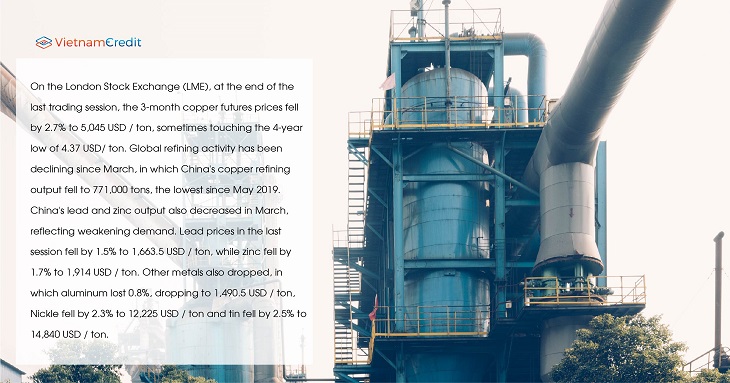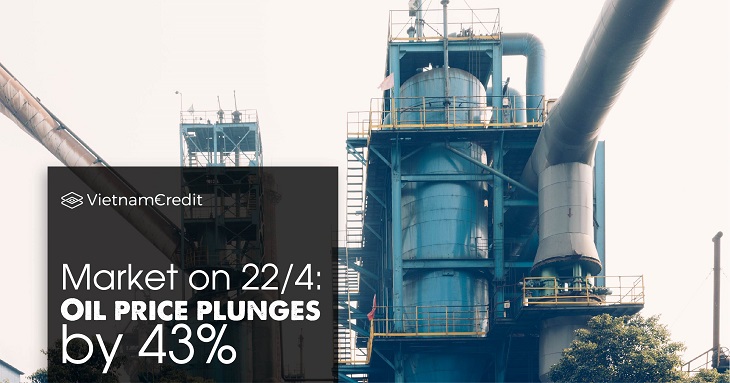The panic in the oil market is making the global commodity markets very complicated.
Many investors sell off commodities with the sentiment of waiting to see if the "collapse" of the energy market will spread to other commodities. That is the reason why most of the prices of goods dropped deeply in the last session.
Brent lost 24% and WTI lost 43% due to fear of oversupply
Oil prices continued to decline in the last session, lengthening a series of panic days as the oversupply situation in this market showed no sign of ending because the COVID-19 pandemic caused a serious decline in energy demand. On the New York Stock Exchange, after falling into the negative zone on 20th April, on 21st April the oil prices marked a major change as more than 2 million contracts were traded – which is the most exciting trading session in history, according to CME Group.
By the end of this session, the 6-month term Brent oil price has dropped by 24% to 19.33 USD/barrel, which is the lowest level since February 2002; the 6-month term WTI has dropped by 8.86 USD, equivalent to 43%, closing the session at 11.57 USD/barrel. The WTI oil futures contract for May 2020 - expired on 21st April- rebounded as it has risen to 10.01 USD per barrel, from negative 37.63 USD on April 20.
Since the beginning of March 2020, when Saudi Arabia, Russia, and its oil allies allied to cut production, crude oil inventories have increased a lot as COVID-19 became increasingly serious.
This pandemic has reduced fuel demand by about 30%. "The math is quite simple. The current oil production is about 90 million barrels a day, but the demand is only 75 million barrels a day," said Gregory Leo, IDB Bank's Chief Investment Officer, and Global Asset Manager said.
Both Saud Arabia and Russia said yesterday they were ready to add measures to stabilize the oil market together with other producing countries but did not specify what that action would be.
Palladium lost more than 15%, gold and other precious metals also plummeted
Gold prices last session fell by nearly 2% to a 2-week low, while palladium lost 15.5% as investors cashed in to cover losses on investments in other risky assets, mainly due to the negative oil price by COVID-19.
At the end of the session, spot gold fell by 1.3% to 1,671.68 USD/ounce, and before that, the price had hit the lowest level since April 9, at 1,659.68 USD/ounce; gold futures in June 2020 dropped by 1.4% to 1,687.80 USD/ounce. More seriously, the palladium price fell by 9.5% to 1,958.00 USD / ounce at the end of the session, after a time of falling to only 1,827.92 USD.
Platinum also fell by 3.3% to 745.29 USD / ounce, and silver fell by 4.3% to 14.71 USD / ounce. Recently, the price of gold bullion has shifted towards volatility closely following the stock market, especially during strong sell-offs in major markets - forcing investors to sell precious metals to cover losses.
Base metal went down due to the impact of oil prices
Base metal prices went down in the last session, in which copper fell by more than 2%, because the oil market is disturbing investor sentiment and pushing global stock markets lower while increasing the USD.

On the London Stock Exchange (LME), at the end of the last trading session, the 3-month copper futures prices fell by 2.7% to 5,045 USD / ton, sometimes touching the 4-year low of 4.37 USD/ ton.
Global refining activity has been declining since March, in which China's copper refining output fell to 771,000 tons, the lowest since May 2019. China's lead and zinc output also decreased in March, reflecting weakening demand.
Lead prices in the last session fell by 1.5% to 1,663.5 USD / ton, while zinc fell by 1.7% to 1,914 USD / ton. Other metals also dropped, in which aluminum lost 0.8%, dropping to 1,490.5 USD / ton, Nickle fell by 2.3% to 12,225 USD / ton and tin fell by 2.5% to 14,840 USD / ton.
Iron ore went down
Iron ore prices on the Chinese market in the last session went down after setting an 8.5-year record in the previous session. This is due to concerns that the oversupply will result from the COVID-19 epidemic, which will reduce the demand in markets outside of China.
At the end of this session, iron ore which futures in September 2020 on the Dalian trading floor decreased by 2.8% to 602 CNY (85 USD) / ton, sometimes dropped sharply by 3.4% to 599 CNY / ton. The falling steel prices have had an impact on the iron ore market. Rebar which futures in October on the Shanghai floor fell by 1.2% to 3,337 CNY / ton.
Hot rolled steel decreased by 1.4% to 3,185 CNY / ton, while stainless steel dropped by 1.3% to 13,030 CNY / ton. Fitch Solutions has lowered its forecast of China's construction sector growth this year to 1.8%, compared with 5.2% of the initial forecast.
Nippon Steel Corp, Japan's largest steelmaker, announced on April 21 that it will temporarily close its third smelter in Japan until mid-May to match the demand which is now declining due to COVID-19.
Palm oil hits a 6-month "bottom" due to the influence of oil
Palm oil prices in the Malaysian market fell to the lowest level in more than 6 months after crude oil prices fell below 0 USD. Crude palm oil in July 2020 on Bursa (Malaysia) decreased by 94 ringgit (4.2%) to 2,138 ringgit (487.29 USD) / ton.
>> The effects of the plummet in oil price on the Vietnamese economy
Source: https://cafef.vn/
























































